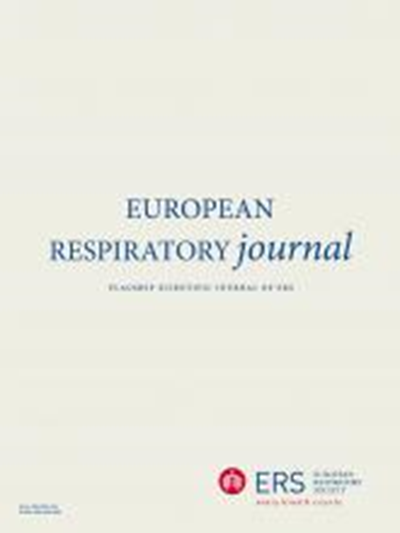肺动脉高压和慢性血栓栓塞性肺动脉高压的肾功能障碍和结局:个体参与者数据荟萃分析。
IF 16.6
1区 医学
Q1 RESPIRATORY SYSTEM
引用次数: 0
摘要
背景肺动脉高压(PAH)和慢性血栓栓塞性肺动脉高压(CTEPH)可引起右心室功能障碍并伴有肺外后遗症,包括肾功能障碍。我们试图表征PAH和CTEPH患者的肾功能障碍,并评估肺动脉高压治疗对肾功能的影响。方法:我们对来自18项肺动脉高压治疗的III期随机临床试验的6694名参与者进行了个体数据荟萃分析。我们使用与种族无关的2021 CKD-EPI方程计算估计肾小球滤过率(eGFR)。结果患者平均年龄49.6±15.5岁,女性占78%,特发性PAH占58%。907名参与者(13.5%)的基线eGFR<60 mL·min-1·1.73 m-2。较低的基线eGFR与较高的平均右房压(mRAP)和较低的心脏指数相关。在12-16周时,mRAP较基线下降10 mmHg或心脏指数增加1 L·min-1·m-2仅与1.7 mL·min-1·1.73 m-2相关(95% CI: -2.9, -0.5;p = 0.006)或1.4毫升·最低为1·1.73 m - 2(95%置信区间CI: 0.5, 2.4;p=0.003), eGFR升高。基线eGFR降低10 mL·min-1·1.73 m-2与全因死亡风险增加相关(aHR: 1.16 [95% CI:1.08, 1.23];p < 0.001)。有趣的是,肺动脉高压治疗仅与12-16周时eGFR的小幅改善相关(aβ: 2.0 mL·min-1·1.73 m-2 [95% CI: 1.4, 2.6];p < 0.001)。结论:PAH和CTEPH患者肾功能不全发生率较高,且与较差的血流动力学和较差的临床预后相关。在这个肾功能相对保存的队列中,肺动脉高压治疗仅与eGFR的微小改善相关。本文章由计算机程序翻译,如有差异,请以英文原文为准。
Renal dysfunction and outcomes in pulmonary arterial hypertension and chronic thromboembolic pulmonary hypertension: an individual participant data meta-analysis.
BACKGROUND
Pulmonary arterial hypertension (PAH) and chronic thromboembolic pulmonary hypertension (CTEPH) cause right ventricular dysfunction with extrapulmonary sequalae including renal dysfunction. We sought to characterize renal dysfunction in PAH and CTEPH and to assess the effect of pulmonary hypertension treatment on renal function.
METHODS
We performed an individual participant data meta-analysis of 6694 participants from 18 phase III randomized clinical trials of pulmonary hypertension therapies. We calculated estimated glomerular filtration rate (eGFR) using the race-agnostic 2021 CKD-EPI equation.
RESULTS
The mean age was 49.6±15.5 years, 78% were female and 58% had idiopathic PAH. A total of 907 participants (13.5%) had a baseline eGFR<60 mL·min-1·1.73 m-2. Lower baseline eGFR correlated with higher mean right atrial pressure (mRAP) and lower cardiac index. At 12-16 weeks, a 10 mmHg decrease in mRAP from baseline or a 1 L·min-1·m-2 increase in cardiac index was associated with only a 1.7 mL·min-1·1.73 m-2 (95% CI: -2.9, -0.5; p=0.006) or a 1.4 mL·min-1·1.73 m-2 (95% CI: 0.5, 2.4; p=0.003) increase in eGFR, respectively. A 10 mL·min-1·1.73 m-2 lower baseline eGFR was associated with an increased risk of all-cause mortality (aHR: 1.16 [95% CI:1.08, 1.23]; p<0.001). Interestingly, pulmonary hypertension treatment was associated with only a small improvement in eGFR at 12-16 weeks (aβ: 2.0 mL·min-1·1.73 m-2 [95% CI: 1.4, 2.6]; p<0.001).
CONCLUSION
Renal dysfunction remains highly prevalent in PAH and CTEPH and is associated with worse hemodynamics and worse clinical outcomes. In this cohort with relatively preserved renal function, pulmonary hypertension treatment was associated with only a minimal improvement in eGFR.
求助全文
通过发布文献求助,成功后即可免费获取论文全文。
去求助
来源期刊

European Respiratory Journal
医学-呼吸系统
CiteScore
27.50
自引率
3.30%
发文量
345
审稿时长
2-4 weeks
期刊介绍:
The European Respiratory Journal (ERJ) is the flagship journal of the European Respiratory Society. It has a current impact factor of 24.9. The journal covers various aspects of adult and paediatric respiratory medicine, including cell biology, epidemiology, immunology, oncology, pathophysiology, imaging, occupational medicine, intensive care, sleep medicine, and thoracic surgery. In addition to original research material, the ERJ publishes editorial commentaries, reviews, short research letters, and correspondence to the editor. The articles are published continuously and collected into 12 monthly issues in two volumes per year.
 求助内容:
求助内容: 应助结果提醒方式:
应助结果提醒方式:


